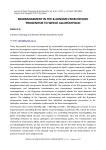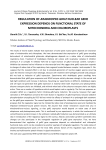Статьи журнала - Журнал стресс-физиологии и биохимии
Все статьи: 1004
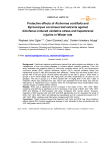
Статья научная
Background: Traditional medicine practitioners claimed that plant extracts are effective in the management of liver and kidney diseases in humans without scientific evidence. Thus, this study evaluated the protective effect of Alchornea cordifolia extract (ACE) and Byrsocarpus coccineus extract (BCE) against diclofenac sodium (DCF) induced oxidative stress and hepatorenal injuries in rats and compared their efficacies. Twenty four rats were divided into 4 groups with 6 rats per group. Normal saline was given to the rats in group 1 while those in groups 3 and 4 were treated with 250 mg/kg ACE and BCE respectively for 28 days by oral gavages. The rats in groups 2 to 4 were injected with 10 mg/kg DCF in the last 7 days of treatment. Blood was collected from rats, serum was separated from the blood and used for estimations of hepatorenal injury markers while the homogenized tissue supernatants were used for assays of oxidative stress markers. Results: There was a significant (p
Бесплатно
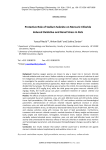
Protective role of sodium selenite on mercuric chloride induced oxidative and renal stress in rats
Статья научная
Backgroud: Reactive oxygen species are known to play a major role in mercuric chloride induced oxidative and renal stress. Sodium selenite as an exogenous source of selenium is used for endogenous selenoprotein synthesis to scavenge the free radicals. The study was designed to investigate the possible protective role of sodium selenite in mercuric chloride induced renal stress, by using biochemical approaches. Adult male Albinos Wistar rats were randomly divided into four groups. The first group was served as the control, the second group was given sodium selenite (0.25 mg/kg b.w), while the third group was given mercuric chloride (0.25 mg/kg), finally, the fourth group was given combined treatment of sodium selenite and mercuric chloride for 3weeks. Results: The effects of sodium selenite on mercuric chloride induced oxidative and renal stress were evaluated by serum creatinine, urea, uric acid, billirubin levels and LDH activity, kidney tissue lipid peroxidation, GSH levels, GSH-Px, GST and catalase activities and hematological parameters. Administration of mercuric chloride induced significant increase in serum: creatinine, urea, uric acid and billirubin concentration showing renal stress. Mercuric chloride also induced oxidative stress, as indicate by decreased kidney tissue of GSH level, GSH-Px, GST, and catalase activities along with increase the level of lipid peroxidation. Furthermore, treatment with mercuric chloride caused a marked elevation of kidney weight and decreased body weight and erythrocytes, hemoglobin, hematocrit levels. Sodium selenite treatment markedly reduced elevated serum: creatinine, urea, uric acid and billirubin levels, and LDH activity and conteracted the deterious effects of mercuric chloride on oxidative stress markers and hematological parameters and atteneuated histopathological changes caused by HgCl 2 in kidney. Conclusion: Our results indicate that sodium selenite could have a beneficial role against mercuric chloride induced nephrotoxicity and oxidative stress in rat.
Бесплатно
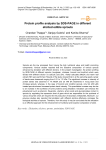
Protein profile analysis by SDS-page in different elicited edible sprouts
Статья научная
Sprouts are the low processed food, having the high nutritional value and health promoting components. Various studies reported that the bioactive composition of various sprouts enhanced by elicitation with different elicitors. In the present investigation, the protein profiling by SDS-PAGE of different sprouts (mungbean, chickpea, broccoli and knolkhol) which were elicited with different elicitor viz salicylic acid (SA), methyl salicylate (MeSA) and neem leaf extract (NE) were performed. Results of the study showed that in all the sprouting seeds variety of bands were obsereved ranging from 8.31 to 112 kDa. The significant increase in intensity of protein bands was observed in 1% MeSA and 20 mM SA treatments in mung bean and chickpea sprouts, whereas, in the case of broccoli and knolkhol sprouts, only SA (200 µM) treated sprouts showed increased protein band intensity. This quantitative increase may be due to an increase in the synthesis of some proteins during elicitation. Elicitation can enhance the polyphenolic such as phenolic, flavanoids, vitamins, amino acids and glucosinolates content in sprouts by regulating the expression level of gene which are responsible for the synthesis of various enzymes which are required for the production of secondary metabolites. Moreover, our previous studies also reported that elicitation with different elicitors effectively increases the biological activities of sprouts. Therefore, from this study it may be concluded that the elicitation is an effective approach for the enhancement of nutritional and bioactive composition of seed.
Бесплатно
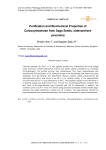
Purification and Biochemical Properties of Carboxylesterase from Saga Seeds (Adenanthera pavonina)
Статья научная
Carboxyl esterase (E.C.No.3.1.1.1) was partially purified from Adenanthera pavonina (Saga) using ammonium sulfate fractionation (0-60%) and DEAE (diethyl aminoethyl) ion exchange chromatography, the purified enzyme was characterized. One major saga-esterase was identified with Fold purification of 29. Molecular weight of the Ap-esterase was determined using Sephadex G-25 gel filtration and SDS-PAGE (Sodium dodecyl sulfate polyacryamide gel electrophoresis) which was found to be 26.0 k Da. Optimal activity of the saga-esterase occurred when the pH 7.0 at a temperature of 55°C. The activation energy for the hydrolysis of α-naphthyl acetate was determined to be 1.10 kcal/ mol. The Michaelis Menton constant (Km) and Vmax of the saga-esterase was 0.4µmoles and 105 IU respectively. In addition, the isoelectric point is at pH > 9 and immuno-blot using polyclonal antibodies showed that the saga-esterase was widely distributed in seeds but not in leaves. The saga-esterase inhibited by organophosphate and carbamate pesticides, which can be substituted for acetylcholinesterase.
Бесплатно
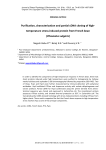
Статья научная
In order to identify the components of high temperature response in French bean, three heat shock proteins induced under high temperature were purified to homogeneity by Carboxy methyl cellulose and sephadex G-100 chromatography followed by preparative SDS-PAGE. Two of these, Hsp1 and Hsp3 were further characterized by immuno-detection with polyclonal antibodies. Hsp3 exhibited ATPase and chaperone activity with malate dehydrogenase and citrate synthase. Partial cDNA for Hsp3 synthesized using the primer derived from amino-terminal sequence was cloned and expressed in Escherichia coli. The recombinant protein possesses ATPase activity, and showed thermal protection at 50°C in Escherichia coli. The translated partial cDNA showed homology with stress induced proteins including ATPases from higher plants. These results supported the fact that French bean response to high temperature stress involves Hsps as one of the principal components.
Бесплатно
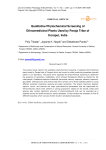
Qualitative Phytochemical Screening of Ethnomedicinal Plants Used by Paraja Tribe of Koraput, India
Статья научная
The present study reports the qualitative phytochemical screening of selected ethnomedicinal plants used by Paraja tribe of Koraput which are known to exhibit medicinal properties reported earlier in our laboratory. The plants were subjected for phytochemical screening to determine the presence of secondary metabolites, which showed therapeutic effects as claimed by the tribal people. Qualitative analysis of alkaloids, flavonoids, tannins, saponins, stereoid, terpenoid, glycosides, anthraquinons and phenol tests were carried out for these selected plants by using different extraction (methanol, acetone and water extraction). The phenol, flavonoid, alkaloid, saponin, tannin, and steroids are major pharmaceutical parameters that are responsible for ethnomedicinal values were present in varying proportions. Based on the results, these plant species also contain significant amounts of phytoconstituents that can be exploited as a potential source for herbal remedy for various diseases. Further studies are necessary to find its different bioactivity which can give fruitful results in phytopharmaceuticals.
Бесплатно
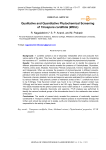
Qualitative and quantitative phytochemical screening of Tinospora cordifolia (Willd.)
Статья научная
Background: T. cordifolia contains a lot of secondary metabolites which are produced from various parts of the plant. They have their specificity in many diseases to cure. By considering the importance of T. cordifolia as medicinal plant to investigate the phytochemical properties. Results: The preliminary phytochemical study was carried out to identify the presence of different phytochemicals and the results revealed the presence of Carbohydrates, Glycosides, Proteins, amino acids, Alkaloids, Flavonoids, Phenolic compounds, Tannins, Saponins, steroids and triterpenoids. When we compare the presence of phytocompounds in different solvents, methanol and aqueous extracts revealed the presence of more phytoconstituents followed by petroleum ether and chloroform solvents. The quantitative analysis of phytochemicals such as Flavonoids, phenols, alkaloids, tannins and saponins were also estimated from methanol extract by various methods. Total phenolic content of methanolic extract of the T. cordifolia was found to be 6.53mg/g. Total flavonoid content was found to be 4.07mg/g, alkaloid content was 5.62mg/g and the tannin content was found to be 5.83 mg/g. Saponin content was 5.02mg/g. The results revealed that the phenol content was more in stem extract of T. cordifolia and it was followed by tannins, alkaloids, flavonoids, and saponins. FT-IR analysis was performed to identify the various functional groups of the biomolecules found in the methanolic stem extract of the plant. Conclusions: The results of present study revealed the presence of medicinally important constituents in Tinospora cordifolia . Traditional medicine practice is recommended strongly that further work should be carried out to isolate, purify and characterize the bioactive compounds responsible for the activity of these plants.
Бесплатно
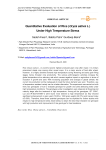
Quantitative Evaluation of Rice (Oryza sativa L.) Under High Temperature Stress
Статья научная
Rice (Oryza sativa L.) is world’s second highest produced grain crop after maize. It is India’s preeminent staple crop among other cereal crops. It is a major source of food after wheat. However, it is highly sensitive towards high temperature during flowering and early grain filling stages hence, threaten crop productivity. The various anthropogenic activities increase the global temperature at an alarming rate which causes negative impact on agriculture in terms of reduction in growth and yield. With increasing population and changes in global climate, the current rice production will be inadequate to meet the future demand very soon. Therefore, use of temperature resistant variety can be a better alternative. The experiment was carried out with thirty two genotypes of rice to evaluate genotype for growth and yield attributing traits under high temperature conditions. The genotypes under investigation were observed at flowering and maturity stage after the treatment of high temperature. Among all the genotypes, IET 23947, Luit and IR-82310-B-B67-2 were found most tolerant to high temperature as they showed significant enhancement in grain yield (70.95%), 1000 grain weight (36.72%) and harvest index (43.58%). Therefore, these three potential genotypes can be exploited for further studies with respect to high temperature stress (heat stress) to obtain the best heat resistant rice genotype with high production and improvement of rice genotype for heat resistance.
Бесплатно
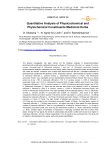
Quantitative analysis of physicochemical and phytochemical constituents medicinal herbs
Статья научная
The present investigation has been carried out the Stastical Analysis of physicochemicaland phytochemical constituents medicinal herbs such as flower of Calendula officinalis Linn, leaves of Lantana camara Linn,aerial part of Oldenlantia herbacea L and root of Peristrophe paniculata Forssk.In physicochemical analysis, parameters such as foreign matter, loss drying,total ash,water and acid soluble ash, water and solvent extractive value of plant were determined.And also the quantitative estimation of phytochemical constituents like alkaloids, tannin, terpenoids, saponin, carbohydrates and protein contents of Calendula officinalis L., Lantana camara L., Oldenlandia herbacea (L.) Roxb., and Peristrophe paniculata Forssk. was undertaken as per standardized procedure.Result showed that Loss on drying turned out to be 1.70% in Calendula officinalis L.,1.61 % in Lantana camara L.,1.45% in Peristrophe paniculata Forssk. and 1.31% in Oldenlandia herbacea Roxb. Foreign matters were found to be 2.36% ( Calendula officinalis L.), 2.67% ( Lantana camara L.), 4.03% ( Peristrophe paniculata Forssk.) and 3.73% in Oldenlandia herbacea (L.) Roxb and the toal ash was found to be relatively 9.46% in Calendula officinalis L. followed by 10.62 % in Lantana camara L., 9.53% in Peristrophe paniculata Forssk. and 8.34% in Oldenlandia herbacea Roxb. The water solubility of all the selected plants 21.74% ( C. officinalis ), 22.43% ( L. camara ), 22.58% ( P. paniculata ) and 22.68% ( O. herbacea ) were found to be higher compared to ethanol and other solvents. The phenol content was higher in Lantana camara L. (15.95mg) followed by Calendula officinalis L. (12.57mg), Peristrophe paniculata Forssk. (10.63mg) and Oldenlandia herbacea (L.) Roxb. (3.70mg). The high content of alkaloid was recorded in Calendula officinalis L.(12.57mg) and low content in the Peristrophe paniculata Forssk. (0.39mg). The total tannin content of Calendula officinalis L. ( 78.93µg) was found to be higher than that of other plants.The total flavonoid content of Calendula officinalis L. was 21.51mg followed by 16.44mg for Lantana camara L., 21.29 mg for Peristrophe paniculata Forssk. and 18.43 mg for Oldenlandia herbacea (L.) Roxb. Oldenlandia herbacea (L.) Roxb. contains higher concentration of terpenoids (11.65mg/g) compared than that of other three plants. Among the four plants, the levels of carbohydrate and protein content were found to be higher in Calendula officinalis L.(61mg; 5.20mg) respectively. From th results it was concluded that this study will be helpful in standardization for quality, purity and sample identification.
Бесплатно
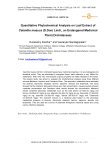
Статья научная
Calanthe masuca (D.Don) Lindl plant leaves have medicinal properties. It is an endangered and terrestrial orchid. They are distributed in evergreen forest; plant collection is very difficult for researches. That’s why very rare because of group of plants not widely represent in the forest. The present study has aimed to evaluate the phytochemical analysis using three different solvents Methanol, Aqueous and Petroleum Ether. The secondary metabolites have estimated into phenols, flavonoids, alkaloids, tannins, saponins, steroids and terpenoids. The result showed that the methanol leaf extract shows as a high concentration. Aqueous extract showed moderate concentration and Petroleum ether extract showed low concentration. Methanol extract contained secondary metabolites such as the total phenol (31.50±0.22 mg/g) and tannins (24.60±0.02 mg/g) as mg, alkaloids (54.40±0.33 mg/g) as mg, flavonoids (73.20±0.62 mg/g) as mg, saponins (35.00±0.05 mg/g), Steroid (60.95±0.57 mg/g) and Terpenoids (14.00±0.26 mg/g). The Calanthe masuca is a medicinal plant based on the secondary metabolites presence of phenols, flavonoids, alkaloids, tannins, saponins, steroids and terpenoids. They are used as a source of potentials therapeutic medicinal values and curing various infectious diseases.
Бесплатно
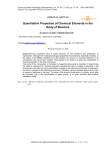
Quantitative properties of chemical elements in the body of bivalves
Статья научная
Biogeochemical processes have a great influence on the presence and distribution of hydrobionts. Although the morphophysiological properties of hydrobionts, especially mollusks, in the region of the Middle Zarafshan are well studied, the amount of chemical elements in its composition has not yet been studied. The purpose of our study is to study the composition of chemical elements in the body of bivalves. The study of the composition of mollusks by biogeochemical parts is important in determining the need of organisms for chemical elements. Because the lack or excess of elements in the environment can lead not only to quantitative changes in the internal environment of organisms, but also to changes in the external environment. Therefore, various diseases arise due to a lack or excess of elements in the body. The study of the amount of elements in mollusks, which play an important role in the bioindication of water quality, is of great scientific and practical importance today.
Бесплатно
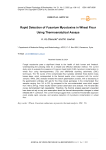
Rapid detection of Fusarium mycotoxins in wheat flour using thermoanalytical assays
Статья научная
Fungal mycotoxins pose a significant threat to the health of both human and livestock. Understanding the pressing need for a reliable and effective detection method. The current study aims to evaluate the presence of Fusarium head blight (FHB) mycotoxin contamination in wheat flour using thermogravimetry (TG) and differential scanning calorimetry (DSC) techniques. The TG curves of the contaminated flour samples exhibited three distinct mass losses steps, which corresponded to the thermal events when compared with the control samples . While, DSC analysis revealed the starch gelatinization process, with a decreasing in the gelatinization enthalpy (ΔH gel) for the three wheat genotypes in the contaminated flour samples ranging from 145 to 203 j/g compared to the non-contaminated ones which ranged from 195 to 254 j/g. These results warrant careful observation and analysis. The TG and DSC curves demonstrated high repeatability. Therefore, the thermal analysis approach presented here does not rely on any prior assumption about the thermal decomposition changes in wheat infected with F. culmorum. The current findings suggest that a combined TG and DSC approach could enable rapid, accurate, and sensitive detection of mycotoxins contamination in wheat flour.
Бесплатно
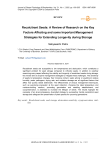
Статья обзорная
Recalcitrant seeds are susceptible to low temperatures and desiccation, which constitutes a significant problem for seed storage compared to orthodox seeds. In addition to carefully examining every aspect affecting the viability and longevity of recalcitrant seeds during storage, this review aims to explore management strategies to mitigate these challenges. The sensitivity of seeds to temperature changes, their moisture content, water activity or equilibrium relative humidity, pests, pathogens, drying rate, and oxidative damage are all significant factors that affect how quickly seeds deteriorate. The effectiveness of various management techniques, such as exercising precaution at the seed collection, choosing the ideal temperature and moisture-holding medium, promoting germination and seedling establishment, and cryopreservation, is assessed to increase the lifespan of seeds. The results highlight the necessity of an all-encompassing, diversified strategy to successfully handle recalcitrant seed storage and safeguard the preservation of plant species for upcoming generations.
Бесплатно
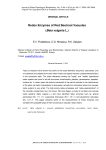
Redox enzymes of red beetroot vacuoles ( Beta vulgaris L.)
Статья научная
Years of research have shown that some of the redox elements (enzymes, coenzymes, and co-substrate) are isolated from each other kinetic and spatial manner (compartmentalization) in the eukaryotic cells. The redox elements forming the "highly" and "widely" specialized redox system are found in all cell structures: mitochondria, plastids, peroxisomes, apoplast, nucleus etc. In recent years the active involvement of the central vacuole in the maintenance of the plant cell redox homeostasis is discussed, actually the information about the vacuolar redox system is very small. The high-priority redox processes and "redox-specialization" of the vacuolar compartment are not known. We have begun a study of red beet-root vacuole redox systems ( Beta vulgaris L.) and have identified redox enzymes such as: phenol peroxidase (EC 1.11.1.7), superoxide dismutase (EC 1.15.1.1) and glutathione reductase (EC 1.8.1.7). This paper presents some of the characteristics of these enzymes and considers the probable ways of their functioning in vacuolar redox chains.
Бесплатно
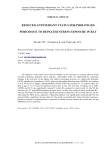
Reduced antioxidant status for prolonged period due to repeated stress exposure in rat
Статья научная
The objective of the study was to find out whether or not exposure to a stressor after an initial stressful experience augments stress response. Antioxidant status was determined by measuring changes in the activities of the hepatic free radical scavenging enzymes viz, superoxide dismutase (SOD), glutathione-S-transferase (GST), glucose-6-phosphate-dehydrogenase (G6PDH) and catalase (CAT) and levels of hepatic malondialdehyde (MDA) following exposure to 1 h restraint (RS) and after a gap of 4 h to forced swimming exercise (FS) in rats. The activities of hepatic CAT, SOD, G6PDH and GST were significantly reduced 2 h after RS compared to controls and 4 h after FS the activities of CAT and G6PDH remained at lower levels i.e. they were similar to those found after RS, whereas SOD and GST showed further significant decrease compared to those found after RS. On the other hand the MDA levels, indicative of lipid peroxidation were significantly increased after RS and showed further significant increase after FS. The results reveal that after initial stressful experience, the stress response is augmented due to exposure to another stressor whereas the system does not get habituated to stress exposure.
Бесплатно
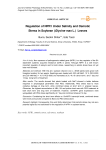
Regulation of NPR1 Under Salinity and Osmotic Stress in Soybean (Glycine max L.) Leaves
Статья научная
Aim of study: Non expressor of pathogenesis related gene (NPR1) is a key regulator of the SA dependent systemic acquired resistance (SAR) in plants. Although NPR1 is a well known important regulator of salicylic acid to biotic stress, researching on abiotic stress have not yet been well founded. Materials and methods: With this aim, soybean (Glycine max L.) SA88 plants were grown with Hoagland solution for two weeks. Seedlings were treated with 200 mM NaCl, 10 % PEG 6000 and 200 mM NaCl + 10 % PEG 6000 and harvested at 2h, 4h, 6h (short term) and 7 day and 14 day (long term) of treatment. Main results: The results showed that plants treated with NaCl showed a better defense response in physiological parameters than PEG. Additionally, PEG stress lead to more oxidative damage at long term, while combined stress at short term in soybean leaves. Otherwise, the highest accumulation of ABA, SA and proline level was with PEG treatment at both short term and long term of treatment. However, GmNPR1 gene expressions were upregulated with PEG stress significantly at 7 day and combined stress at 14 day. Discussion: Considering the short term effects on GmNPR1 transcript levels, combined stress were more pronounced compared to NaCl and PEG stress alone. Research highligts: Consequently, this work firstly determined that osmotic stress may role as a potential signal but not salt stress for the regulation of NPR1 in soybean leaves.
Бесплатно
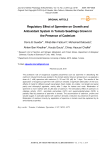
Статья научная
The protective role of exogenous supplied polyamines such as spermine in detoxifying the cadmium induced toxicity was studied in the tomato plants Solanum lycopersicum , we applied a dose of (1 mM) spermine with cadmium (0, 20 and 100 µM) for 7 days. The results of the application of exogenous spermine with cadmium showed a significant attenuation of the toxic effects of metal for different growth parameters (fresh matter, dry matter, root length and aerial parts) and chlorophyll pigments, mainly after 3 days for leaves and roots. Moderation of spermine is more marked with 20 µM dose of cadmium. The stimulatory effect of cadmium on catalase activity (CAT), ascorbate peroxidase (APX) and superoxidedismutase (SOD) is partially lifted by presence of spermine in tomato. The accumulation of cadmium, proline and soluble sugars in cultivated plants with cadmium showed a reduction by presence of spermine. Moderation of cadmium toxicity by application of spermine in tomato could be explained by its antioxidants properties.
Бесплатно
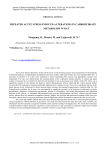
Repeated acute stress induced alterations in carbohydrate metabolism in rat
Статья научная
Acute stress induced alterations in the activity levels of rate limiting enzymes and concentration of intermediates of different pathways of carbohydrate metabolism have been studied. Adult male Wistar rats were restrained (RS) for 1 h and after an interval of 4 h they were subjected to forced swimming (FS) exercise and appropriate controls were maintained. Five rats were killed before the commencement of the experiment (initial controls), 5 control and equal number of stressed rats were killed 2 h after RS and remaining 5 rats in each group were killed 4 h after FS. There was a significant increase in the adrenal 3в- hydroxy steroid dehydrogenase activity following RS, which showed further increase after FS compared to controls and thereby indicated stress response of rats. There was a significant increase in the blood glucose levels following RS which showed further increase and reached hyperglycemic condition after FS. The hyperglycemic condition due to stress was accompanied by significant increases in the activities of glutamate- pyruvate transaminase, glutamate- oxaloacetate transaminase, glucose -6- phosphatase and lactate dehydrogenase and significant decrease in the glucose -6- phosphate dehydrogenase and pyruvate dehydrogenase activities, whereas pyruvate kinase activity did not show any alteration compared to controls. Further, the glycogen and total protein contents of the liver were decreased whereas those of pyruvate and lactate showed significant increase compared to controls after RS as well as FS. The results put together indicate that acute stress induced hyperglycemia results due to increased gluconeogenesis and glycogenolysis without alteration in glycolysis. The study first time reveals that after first acute stress exposure, the subsequent stressful experience augments metabolic stress response leading to hyperglycemia. The results have relevance to human health as human beings are exposed to several stressors in a day and such an experience might lead to insulin resistance because prolonged hyperglycemic condition is known to cause insulin resistance.
Бесплатно

